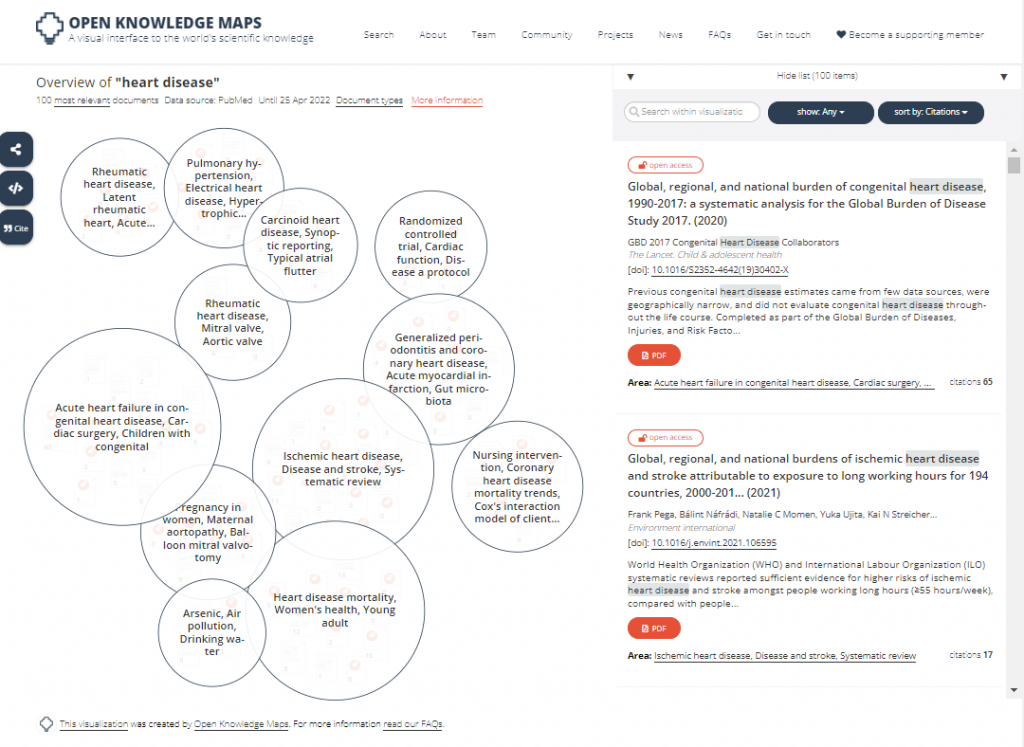In this week’s Research Bridge Blog, we introduce Open Knowledge Maps, a free online tool for creating visual overviews of research topics.
What is Open Knowledge Maps?
Open Knowledge Maps is a service developed by a Vienna-based not-for-profit organization of the same name. Open Knowledge Maps’ search engine enables researchers and students to quickly identify relevant resources by creating knowledge maps. After five years of testing in beta, the tool officially released in Nov 2021. In this post, we will demonstrate this tool using the topic “heart disease” as an example.
How does Open Knowledge Maps work?
Get an instant overview of a topic
By running a keyword search query, Open Knowledge Maps pulls out 100 most relevant documents from a specific search engine (BASE or PubMed) and will generate a knowledge map with a number of main areas and relevant papers attached to each area (Figure. 1). By design, this tool aims to keep cognitive load to a manageable amount, and therefore the total number of documents included for a knowledge map is kept at 100.

Figure 1. Relevant sub-topics under heart disease are represented as bubbles, such as types of diseases, patient, and prevention
How are relevant concepts identified?
One of the most difficult tasks when we are new in a research field is to learn the “language” of the field. The visualization is intended to give us a head start: The visualization makes it possible to easily identify useful, pertinent information and it is much more intuitive as compared to traditional lists of search results that are yielded from most indexes and databases.
Currently, text similarly in titles, abstracts, authors, journals, and subject keywords are used to create a word co-occurrence matrix between articles. Closeness of areas implies subject similarity. The map is particularly helpful in helping us identify cross-disciplinary sub-areas, as big research questions/problems of our time (e.g., climate, health well-being, clean energy, quality education) require an interdisciplinary approach.
Find open content
Open Knowledge Maps includes not only journal articles, but also content such as data sets and research software indexed in BASE and PubMed. In addition, it highlights open access documents – and the majority of those documents can be read from within the interface on your browser.
Roadmap of Open Knowledge Maps
As a non-profit, Open Knowledge Maps endorses open science principles. Source code, content and data (hosted on GitHub) are all shared under open licenses. As of Nov 2021, Open Knowledge Maps has recorded more than 1.3 million website visits and more than 600,000 maps were created. In future, the organization aims to enable their users to collaboratively curate and discuss the knowledge maps on the platform, thus transforming discovery from a closed individual process to an open and collaborative one.
More Information
- FAQ: https://openknowledgemaps.org/faq
- News: https://openknowledgemaps.org/news
- Roadmap: https://github.com/OpenKnowledgeMaps/open-discovery/blob/master/roadmap.md
– By Jennifer Gu, Library
Views: 853
Go Back to page Top
- Category:
- Research Tools
Tags: open knowledge maps, open science tools, research discovery
published April 28, 2022


